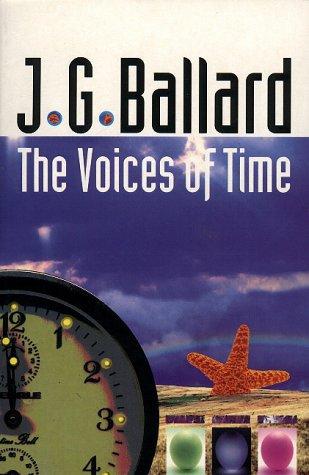Paperback, 197 pages
Published Dec. 2, 1997 by Orion mass market paperback.

Paperback, 197 pages
Published Dec. 2, 1997 by Orion mass market paperback.
Comment by Christopher Priest, on The Guardian's website: The Voices of Time by JG Ballard (1960)
When he died two years ago, JG Ballard was widely celebrated for his novels, and rightly. Empire of the Sun, an account of his wartime internment in Shanghai, brought him a Spielberg movie and a worldwide audience, but he also wrote the remarkable novels Crash, High-Rise, Cocaine Nights and many more. Inspired by Dalí, De Chirico, William Burroughs and Jean Genet, his talent was unique: his vivid, surprising and often beautiful prose was put to the creation of dreamlike and sometimes shocking images, while telling a deceptively straightforward narrative.
Ballard began writing in 1955 (he was in his mid-20s) and his first serious novel, The Drowned World, did not appear until seven years later. Before that he produced a stream of astonishing short stories, which to long-term admirers of …
Comment by Christopher Priest, on The Guardian's website: The Voices of Time by JG Ballard (1960)
When he died two years ago, JG Ballard was widely celebrated for his novels, and rightly. Empire of the Sun, an account of his wartime internment in Shanghai, brought him a Spielberg movie and a worldwide audience, but he also wrote the remarkable novels Crash, High-Rise, Cocaine Nights and many more. Inspired by Dalí, De Chirico, William Burroughs and Jean Genet, his talent was unique: his vivid, surprising and often beautiful prose was put to the creation of dreamlike and sometimes shocking images, while telling a deceptively straightforward narrative.
Ballard began writing in 1955 (he was in his mid-20s) and his first serious novel, The Drowned World, did not appear until seven years later. Before that he produced a stream of astonishing short stories, which to long-term admirers of Ballard's writing are among his finest fiction. In them he explored for the first time many of the themes which in new guises were to coil their way through his better known later work. Supreme in these stories is an extraordinary novella, The Voices of Time, first published in 1960 and later the title story of a collection.
The plot almost defies summary. An imminent global disaster is seen from the viewpoint of a group of sleep-addicted scientists, slowly going mad in a desert installation surrounded by salt lakes, where genetic experiments have bred mutant animals to resist the radiated atmosphere. Meanwhile, a countdown to the end of the universe has begun, a suicidal madman engraves a mandala on the floor of an emptied swimming pool, a sleep-deprived astronomer cruises the dunes in a white Packard saloon, a raven-haired temptress named Coma plays the men off against each other. Somehow it all seems to make crazy and brilliant sense. I have read the story a dozen times, never actually understood it, but also have never failed to draw inspiration and encouragement from Ballard's pellucid writing and the amazing and surreal images.